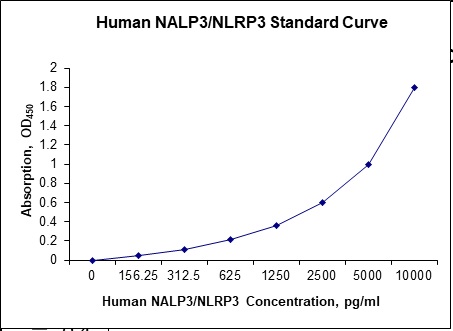Nori Human NLRP3 (NALP3) ELISA Kit
$461.00 – $832.00
This ELISA kit is for quantification of NLRP3/NALP3 in human. This is a quick ELISA assay that reduces time to 50% compared to the conventional method, and the entire assay only takes 3 hours. This assay employs the quantitative sandwich enzyme immunoassay technique and uses biotin-streptavidin chemistry to improve the performance of the assays. An antibody specific for NLRP3 has been pre-coated onto a microplate. Standards and samples are pipetted into the wells and any NLRP3 present is bound by the immobilized antibody. After washing away any unbound substances, a detection antibody specific for NLRP3 is added to the wells. Following wash to remove any unbound antibody reagent, a detection reagent is added. After intensive wash a substrate solution is added to the wells and color develops in proportion to the amount of NLRP3 bound in the initial step. The color development is stopped, and the intensity of the color is measured.
Alternative names for NLRP3: NLR family pyrin domain containing 3, NACHT, LRR and PYD domains-containing protein 3 (NALP3)
This product is for laboratory research use only not for diagnostic and therapeutic purposes or any other purposes.
- Description
- How Elisa Works
- Product Citations
- Reviews (0)
Description
Nori Human NLRP3 ELISA Kit Summary
Alternative names for NLRP3: NLR family pyrin domain containing 3, NACHT, LRR and PYD domains-containing protein 3 (NALP3)
| Assay Type | Solid Phase Sandwich ELISA |
| Format | 96-well Microplate or 96-Well Strip Microplate |
| Method of Detection | Colorimetric |
| Number of Targets Detected | 1 |
| Target Antigen Accession Number | Q96P20 |
| Assay Length | 3 hours |
| Quantitative/Semiquantitative | Quantitative |
| Sample Type | Plasma, Serum, Cell Culture, Urine, Cell/Tissue Lysates, Synovial Fluid, BAL, |
| Recommended Sample Dilution (Plasma/Serum) | No dilution for sample <ULOQ; sufficient dilution for samples >ULOQ |
| Sensitivity | 30 pg/mL |
| Detection Range | 156-10000 pg/mL |
| Specificity | Natural and recombinant human NLRP3 |
| Cross-Reactivity | < 0.5% cross-reactivity observed with available related molecules, < 50% cross-species reactivity observed with species tested. |
| Interference | No significant interference observed with available related molecules |
| Storage/Stability | 4 ºC for up to 6 months |
| Usage | For Laboratory Research Use Only. Not for diagnostic or therapeutic use. |
| Additional Notes | The kit allows for use in multiple experiments. |
Standard Curve
Kit Components
1. Pre-coated 96-well Microplate
2. Biotinylated Detection Antibody
3. Streptavidin-HRP Conjugate
4. Lyophilized Standards
5. TMB One-Step Substrate
6. Stop Solution
7. 20 x PBS
8. Assay Buffer
Other Materials Required but not Provided:
1. Microplate Reader capable of measuring absorption at 450 nm
2. Log-log graph paper or computer and software for ELISA data analysis
3. Precision pipettes (1-1000 µl)
4. Multi-channel pipettes (300 µl)
5. Distilled or deionized water
Protocol Outline
1. Prepare all reagents, samples and standards as instructed in the datasheet.
2. Add 100 µl of Standard or samples to each well and incubate 1 h at RT.
3. Add 100 µl of Working Detection Antibody to each well and incubate 1 h at RT.
4. Add 100 µl of Working Streptavidin-HRP to each well and incubate 20 min at RT.
5. Add 100 µl of Substrate to each well and incubate 5-30 min at RT.
6. Add 50 µl of Stop Solution to each well and read at 450 nm immediately.
Background:
NACHT, LRR and PYD domains-containing protein 3 (NALP3), also known as cryopyrin, is a protein that in Canines is encoded by the NLRP3 gene. NALP3 is expressed predominantly in macrophages and and its activation triggers an immune response. Mutations in the NLRP3 gene are associated with a number of organ specific autoimmune diseases such as CAPS, FCAS, MWS, CINCA, NOMID.[1] NALP3 is a component of the innate immune system that functions as a pattern recognition receptor (PRR) that recognizes pathogen-associated molecular patterns (PAMPs).[2] NALP3 belongs to the NOD-like receptor (NLR) subfamily of PRRs and NALP3 together with the adaptor ASC protein PYCARD forms a caspase-1 activating complex known as the NALP3 inflammasome. NALP3 in the absence of activating signal is kept in an inactive state complexed with HSP90 and SGT1 in the cytoplasm. NALP3 inflammasome detects danger signals such as crystalline uric acid and extracellular ATP released by damaged cells. These signals release HSP90 and SGT1 from and recruit ASC protein and caspase-1 to the inflammasome complex. Caspase-1 within the activated NALP3 inflammasome complex in turn activates the inflammatory cytokine, IL-1β.[2] The NALP3 inflammasome appears to be activated by changes in intracellular potassium caused by potassium efflux from mechanosensitive ion channels located in the cell membrane.[3] It appears that NALP3 is also regulated by reactive oxygen species, though the precise mechanisms of such regulation has not been determined.[4] Amelioration of Canine models of many diseases has been shown to occur by deletion of the NLRP3 inflammasome, including gout, type 2 diabetes, multiple sclerosis, Alzheimer’s disease, and atherosclerosis.[5]
References
- Turunen JA, et al. (2018). American Journal of Ophthalmology. 184: 41–50.
- Martinon F (2008). Journal of Leukocyte Biology. 83 (3): 507–11.
- Hari A, et al. (2014). Scientific Reports. 4: 7281. doi:1038/srep07281.
- Haneklaus M, et al. (2013). Current Opinion in Immunology. 25 (1): 40–45.
- Levy M, et al. (2015). 21 (3): 213–215.
Product Citations
Be the first to review “Nori Human NLRP3 (NALP3) ELISA Kit”
You must be logged in to post a review.




























Reviews
There are no reviews yet.